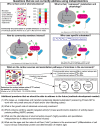Metaproteomics: Much More than Measuring Gene Expression in Microbial Communities
- PMID: 31117019
- PMCID: PMC6529545
- DOI: 10.1128/mSystems.00115-19
Metaproteomics: Much More than Measuring Gene Expression in Microbial Communities
Abstract
Metaproteomics is the large-scale identification and quantification of proteins from microbial communities and thus provides direct insight into the phenotypes of microorganisms on the molecular level. Initially, metaproteomics was mainly used to assess the "expressed" metabolism and physiology of microbial community members. However, recently developed metaproteomic tools allow quantification of per-species biomass to determine community structure, in situ carbon sources of community members, and the uptake of labeled substrates by community members. In this perspective, I provide a brief overview of the questions that we can currently address, as well as new metaproteomics-based approaches that we and others are developing to address even more questions in the study of microbial communities and plant and animal microbiota. I also highlight some areas and technologies where I anticipate developments and potentially major breakthroughs in the next 5 years and beyond.
Keywords: LC-MS; metagenomics; metaproteomics; metatranscriptomics; microbiome; microbiota; proteomics; symbiosis.
Copyright © 2019 Kleiner.
Conflict of interest statement
Conflict of Interest Disclosures: M.K. has nothing to disclose.
Figures
References
-
- Kleiner M, Wentrup C, Lott C, Teeling H, Wetzel S, Young J, Chang Y-J, Shah M, VerBerkmoes NC, Zarzycki J, Fuchs G, Markert S, Hempel K, Voigt B, Becher D, Liebeke M, Lalk M, Albrecht D, Hecker M, Schweder T, Dubilier N. 2012. Metaproteomics of a gutless marine worm and its symbiotic microbial community reveal unusual pathways for carbon and energy use. Proc Natl Acad Sci U S A 109:E1173–E1182. doi:10.1073/pnas.1121198109. - DOI - PMC - PubMed
-
- Hamann E, Gruber-Vodicka H, Kleiner M, Tegetmeyer HE, Riedel D, Littmann S, Chen J, Milucka J, Viehweger B, Becker KW, Dong X, Stairs CW, Hinrichs K-U, Brown MW, Roger AJ, Strous M. 2016. Environmental Breviatea harbour mutualistic Arcobacter epibionts. Nature 534:254–258. doi:10.1038/nature18297. - DOI - PMC - PubMed
LinkOut - more resources
Full Text Sources
Other Literature Sources


